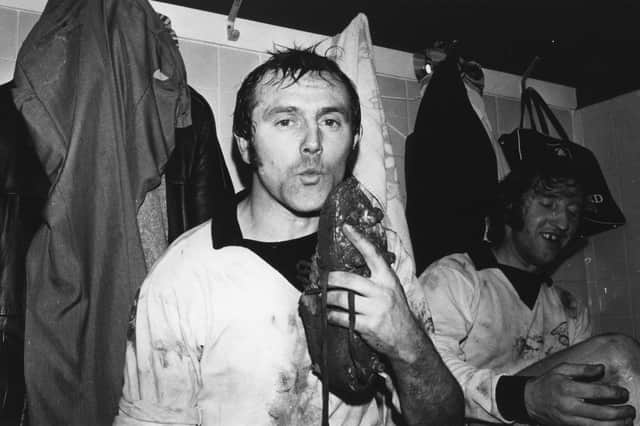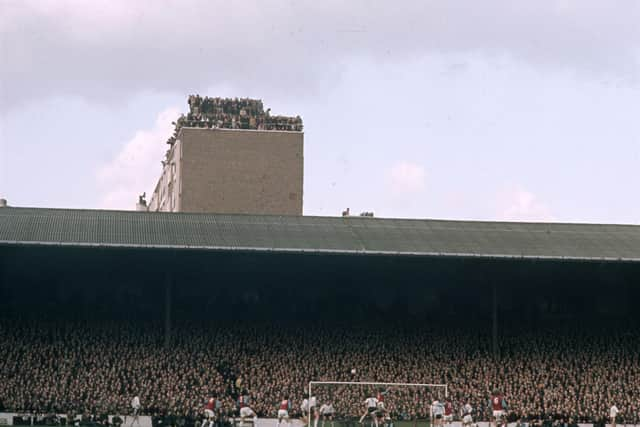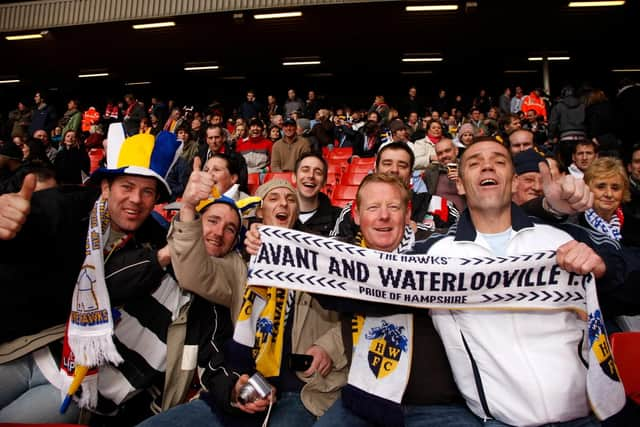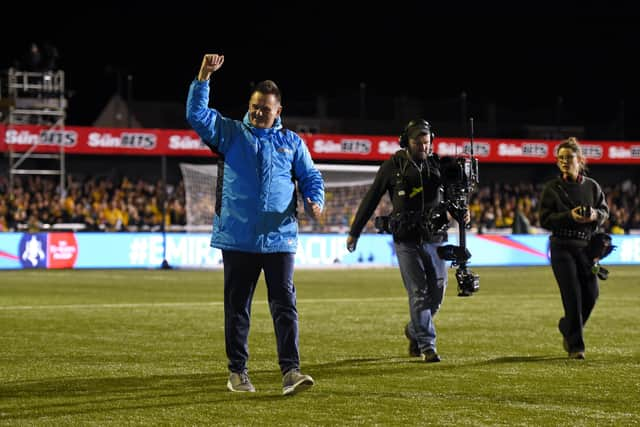COMMENT: Much has changed since Ronnie Radford’s thunderbolt, but thankfully the FA Cup STILL matters to so many ...


For anyone who loves football - and I mean really loves it, I’m not talking about your average armchair Premier League tourist here - it is 15 minutes and 31 seconds of action that still possesses the power, all these decades on, to make the hairs on the back of your neck stand up.
This is a big shout I’m about to make, but I’m happy to make it - it’s the finest 15 minutes and 31 seconds of sporting action you will find on YouTube (outside of watching your own club).
Advertisement
Hide AdAdvertisement
Hide AdI’ve watched it before, but in this week - an FA Cup week, no less - I watched it again. Well, we’re in the middle of a national lockdown, so why not? I haven’t got Netflix so I can’t watch The Crown, and Ant and Dec annoy me.


Anyway, why watch the reworking of Charles and Di’s history, or critters crawling in the knickers of so-called celebs, when you sit back, relax and watch the greatest FA Cup goal of all time, followed by the greatest FA Cup pitch invasion of all time?
It’s a no-brainer really.
Of course, I’m talking about the events of February 5, 1972, at Edgar Street - home of Hereford United. Over 14,000 packed into the ground - almost everyone under the age of 16 was wearing a Parka coat - to watch the hosts become the first non-league club since 1949 to dump top flight opposition, in their case Newcastle United, out of the FA Cup.
If you couldn’t get in, you could climb up a tree outside instead and watch the game for free. You don’t see fans up trees anymore, and more’s the pity. Back in the 70s and 80s, some used to climb the floodlight pylons for a better view. You don’t get that anymore either, another sad loss for those of us who remember less stringent health and safety regulations.
Advertisement
Hide AdAdvertisement
Hide Ad

On one of those mudbaths which are synonymous with 1970s football - think the Baseball Ground, Stamford Bridge, Highbury - Newcastle appeared on course for victory in a third round replay when Malcolm Macdonald scored eight minutes from time.
Ronnie Radford’s 35-yard thunderbolt three minutes later earned him a place in FA Cup immortality, to be engulfed by hundreds of Parka-clad kids within seconds. Ricky George’s extra time winner resulted in another pitch invasion, with a third inevitably arriving at the final whistle.
There was nothing sinister about all those kids running on the pitch; they were just spur-of-the-moment celebrations in a far more innocent era. I know this for sure - if I was one of those pitch invaders, I wouldn’t be able to watch the footage today without a tear being pushed down my cheek.
It is a reminder, and a much-needed one, that once upon a time the FA Cup mattered. I mean, it REALLY mattered. It mattered to the fans of the most famous clubs in the land, and it mattered to those who followed the non-league minnows. It mattered to the professionals and it mattered to the part-timers.
Advertisement
Hide AdAdvertisement
Hide Ad

Somehow, somewhere, part of that enduring magic has been lost down the years.
Give a Premier League club the choice of finishing third or fourth in the league or winning the FA Cup, they would choose the former with its potentially lucrative Champions League qualification. Sadly, most fans would probably agree with their chief executives and owners.
Of course, it’s all about money. I understand that. But whatever happened to glory? Whatever happened to romance? Why do mid-table Premier League clubs continually field below-strength teams in a tournament they have a chance of winning?
As a footballing romantic, I miss the fact the FA Cup doesn’t seem as important today as it once was. Indeed, as it was on February 5, 1972, in one corner of rural Herefordshire, a county never regarded as a footballing hotbed.
Advertisement
Hide AdAdvertisement
Hide AdAs it was at West Ham in the fourth round that season, where over 42,000 crammed into Upton Park to watch a replay with Hereford - higher than any of the Hammers’ First Division crowds that season and 15,000 above their league average in 1971/72.
Fans were so keen to watch a non-league team they stood on top of an east London tower block to grab what view they could.
As it was in 1974/75, when non-league Altrincham drew at top flight Everton. The replay was moved to Old Trafford on police advice, and attracted 35,530.
The same season, non-league Wimbledon, having already won in the third round at top flight Burnley, drew 0-0 at reigning First Division champions Leeds in front of 46,230 at Elland Road.
Advertisement
Hide AdAdvertisement
Hide AdThe replay was held at Crystal Palace’s Selhurst Park on police advice, and was watched by a crowd of over 45,000.
The FA Cup mattered in 1976/77 when two Division 3 clubs - Crystal Palace and Brighton - attracted large crowds for a first round tie.
First, 29,584 were at Brighton’s Goldstone to watch a 2-2 draw. A few days later, 29,174 saw another draw - this time 1-1 - at Selhurst Park.
Another 14,118 attended a second replay held at Chelsea’s Stamford Bridge - meaning 72,876 had watched three FA Cup ties involving the same two third tier teams.
Advertisement
Hide AdAdvertisement
Hide AdIn the third round, Palace drew 0-0 at Anfield before losing the replay in front of 42,807 - not a bad attendance for a Division 3 club!
The FA Cup still mattered in 1977/78, when non-league Blyth Spartans were drawn at home to Wrexham in the fifth round. The tie was switched to neighbouring Newcastle’s St James’ Park, and 42,167 packed in to watch it.
In 1980/81, non-league Enfield switched their FA Cup fourth round replay with Division 3 Barnsley - with respect, not the most glamorous of opponents - to Tottenham’s White Hart Lane. They were rewarded with a crowd of 35,244 - higher than Tottenham’s First Division average crowd that season. Incredible, when you think about it.
But that was the FA Cup back then, where non-league clubs could attract ‘home’ crowds of over 40,000. We will never see those days again.
Advertisement
Hide AdAdvertisement
Hide AdBut thankfully, as we moved into a new millennium, and despite attempts to lessen its importance, the tournament has continued to produce its fair share of classic romance.
In many ways, none better than Havant & Waterlooville’s run to the fourth round in 2007/08. No club from the sixth tier of English football has reached the last 32 since.
It wasn’t just that Shaun Gale’s men played at Anfield - one of the world’s ultimate sporting cathedrals - and actually led Liverpool twice. No, it was much more than that.
For a cup run to be truly memorable, it needs victories over higher division opposition - and Hawks had three in a row, against York City, Notts County and Swansea City. It got progressively better too - wins against teams from one, two and three divisions higher in the pyramid. Now THAT is a cup run!
Advertisement
Hide AdAdvertisement
Hide AdHow I wish I had been at Westleigh Park for the Swansea replay. With a trip to Anfield up for grabs, Hawks won 4-2. It was a throwback to everything great about the FA Cup - a huge upset, a small ground, under floodlights, a ‘minnow’ earning their 15 minutes of Warholian fame, a wonderful reward (for the players and, on the back of a 42,566 crowd at Liverpool, for the bank balance too).
Current Hawks boss Paul Doswell is also no stranger to a classic FA Cup romance story. In 2016/17, he managed Sutton United to the fifth round - one of only nine non-league clubs in post-war history to reach the last 16.
Again, there were three wins over higher division opposition, and again more impressive each time - Cheltenham (League Two), AFC Wimbledon (League One) and Leeds United (Championship).
Doswell, briefly, was a household name in the same way Gale had been nine years earlier, and Sutton’s fifth round tie at home to Arsenal shown was screened live on the BBC.
Advertisement
Hide AdAdvertisement
Hide AdTry telling Doswell the FA Cup no longer matters as much as it did. Try telling that to the Hawks fans who travelled to Anfield. Try telling that to the record number of non-league clubs - 14 - who are in second round action this weekend all hoping for a win and a trip to Old Trafford or Anfield.
Tell that to Hawks’ second round opponents Marine, who dumped four divisions higher Colchester out earlier this month - the equivalent of Eastleigh beating Premier League opposition.
We might not have mudbaths any more, we might not have many terraces left outside of non-league, Parka coats have drifted out of fashion, and more managers and fans seem to declare ‘the league is the priority’ as the years go by. The next time I hear the phrase ‘I’d swap a cup win for three points’ I’ll scream really loudly.
For this season, more big changes - there are no replays in 2020/21 and there will no fans’ pitch invasions this weekend because there won’t be any fans, just as there weren’t any in the fourth qualifying round or first round proper.
Advertisement
Hide AdAdvertisement
Hide AdBut despite all that, and almost half a century on from Ronnie Radford’s shot sailing into the top corner of the Newcastle net, the FA Cup still matters to so many. We should rejoice in that. If you consider yourself a ‘proper’ football fan, it should still matter to you ...